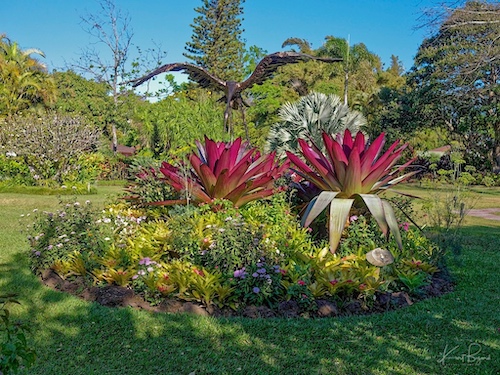
The Hotel Bougainvillea is a relatively small, privately owned hotel in a suburb of San José in Santo Domingo near Santa Rosa in the Herdia province popular as a starting point for nature tours in Costa Rica. Part of the reason making this a popular choice is the affordable prices but the real selling point of the hotel is the 10 acre garden. It has been my experience that the most beautiful, varied and interesting gardens are created by a collector. While I never met the owner(s), this is truly a world class garden, with sculpture, mature local and special rare species from the surrounding countries and even an amazing rock collection. The rooms are typical of a Motel 6 but the restaurant is good, especially with local favorites and it has air conditioning. The Costa Rica National Gardening Association has given them an award as the best garden in Costa Rica. In this garden you can find small samples of the country’s crops, such as coffee, cocoa, bananas, pineapple and papaya. They have 22 types of bromeliads, 51 different orchids, 28 types of heliconia and 29 types of lilies among many other plants. Because it was winter, I only got to see a fraction of the garden in bloom but trust me, this is a garden you will want to visit.
Hotel Bougainvillea
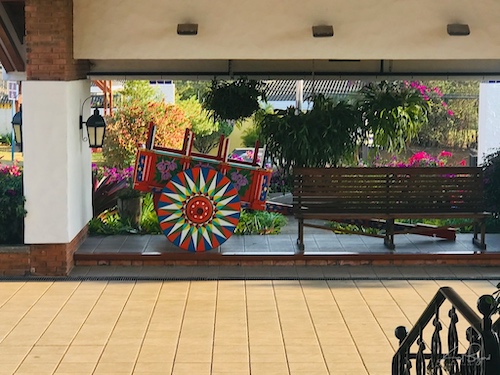
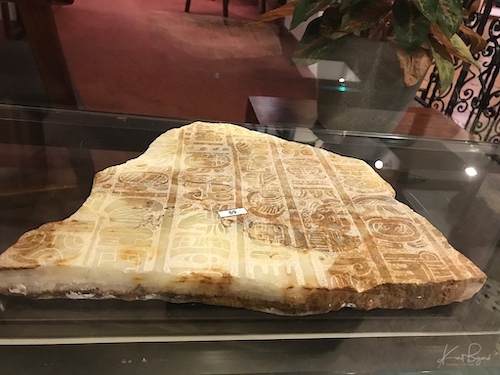
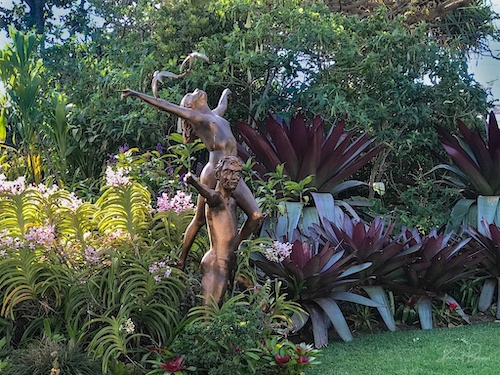
Ok, so I wanted to add some photos to give a sense of the place. You can see the collector in these photographs and you would be remiss if you visit Costa Rica without a survey of these gardens.
Red Hot Poker Tree
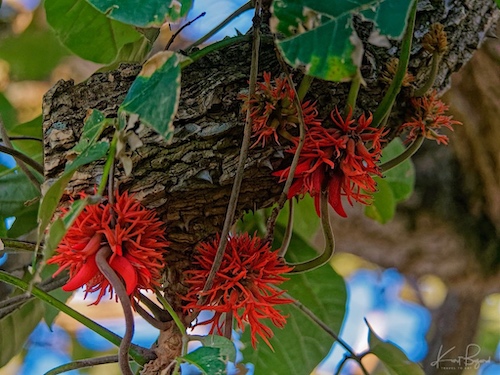
Erythrina abyssinica is a tree species of the genus Erythrina belonging to the plant family of the Fabaceae (or Leguminosae) described by Augustin Pyramus de Candolle in 1825. This leguminous tree species is native to East Africa , Eastern DRC and southern Africa.
Chenille Plant
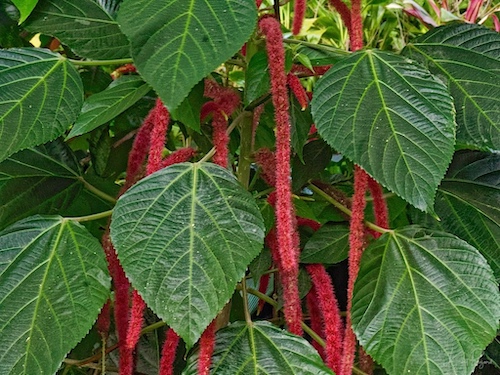
This plant is also known as the Philippines Medusa, red hot cat’s tail and fox tail in English, pokok ekor kucing in Malay, Rabo de Gato in Portuguese, Tai tượng đuôi chồn in Vietnamese, poochavaal in Malayalam and shibjhul in Bengali. Acalypha hispida is cultivated as a house plant because of its attractiveness and brilliantly colored, furry flowers. The plant originated in tropical Asia, specifically Malesia and Papuasia, but has become naturalized to multiple countries in North America, including the United States, Mexico, and Belize.
Euphorbia geroldii
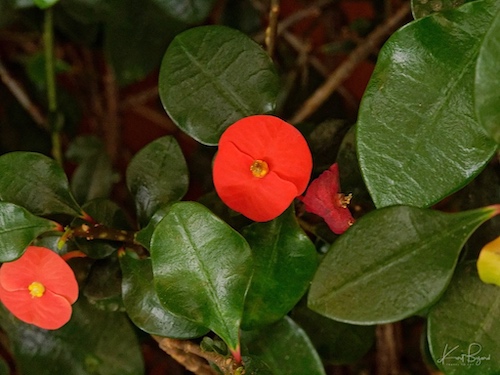
Euphorbia geroldii is a species of plant in the family Euphorbiaceae. It is endemic to Madagascar. Its natural habitat is subtropical or tropical dry forests. It is threatened by habitat loss. A thornless Crown of Thorns that produces a non-stop show of bright glowing red, 1–1/2” wide crown of thorn blooms throughout the year atop the thornless stems and glossy green foliage.
Egyptian Star Cluster
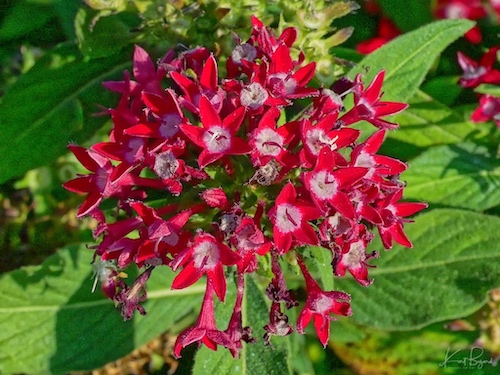
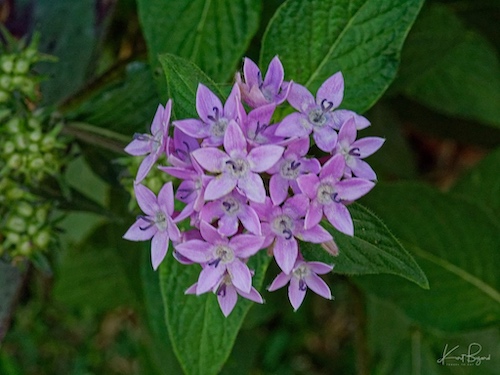
Pentas lanceolata, commonly called Egyptian star cluster or star flower, is native from Yemen to East Africa. It is a tropical woody-based perennial or subshrub that grows 3–6’ tall in its native habitat, but more typically to 1–2’ tall in beds or containers.
Striped Barbados Lily
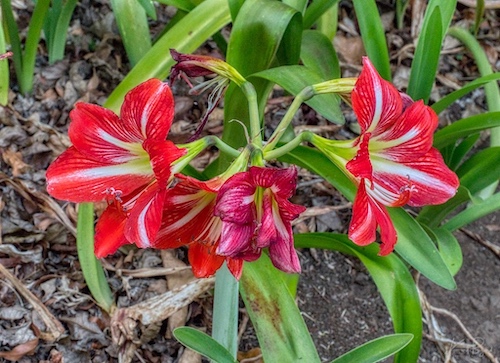
Hippeastrum striatum (striped Barbados lily) a flowering perennial herbaceous bulbous plant, in the family Amaryllidaceae, native to the southern and eastern regions of Brazil. The Barbados lily also goes by the common names amaryllis lily, fire lily, lily of the palace, Easter lily and cocoa lily. It is a bulbous perennial native to Mexico, Central America, and South America, but is commonly grown for its ornamental and medicinal value in other locations. Barbados lily produces trumpet-like flowers that are usually red or orange but can be a variety of colors, including pink and white.
Peruvian Zinnia
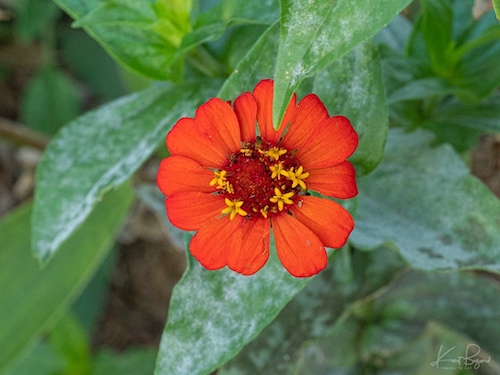
Zinnia peruviana, the Peruvian zinnia, is an annual flowering plant in the family Asteraceae. It is native to North America and South America. The native range of Z. peruviana spans from southeastern Arizona and the Greater Antilles south to Argentina. It grows mostly on open areas or rocky slopes between 800–3000 m of elevation. It has been introduced to and naturalized in many places such as China, India, Bangladesh, Australia, South Africa and Hawaii.
Marmalade Bush
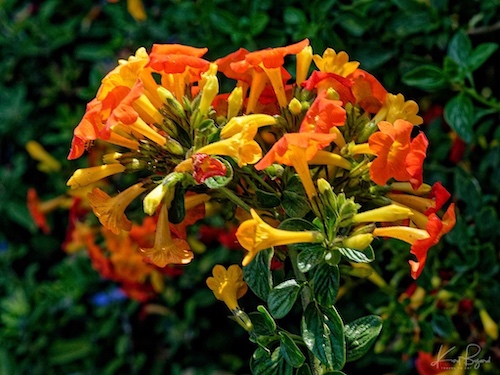
Streptosolen is a monotypic genus of flowering plants of the family Solanaceae. It is closely related to the genus Browallia, within which it was originally placed. The single species, Streptosolen jamesonii, the marmalade bush or fire bush, is an evergreen shrub bearing loose clusters of flowers which change gradually from yellow to red as they develop, resulting in an overall appearance resembling orange marmalade (whence the name), found in open woodlands in Colombia, Venezuela, Ecuador, and Peru. Two other English vernacular names sometimes applied to the shrub are Orange Browallia and Yellow Heliotrope shrub. The red coloration (at maturity) of the flowers of Streptosolen jamesonii is typical of that of bird-pollinated flowers, as also is their lack of a strong scent and secretion of a great deal of nectar. The iridescent green hummingbird species Chlorostilbon poortmani, the short-tailed emerald, is a frequent visitor to the flowers of Streptosolen jamesonii, pollinating them as it hovers to sip their nectar.
Ti Plant
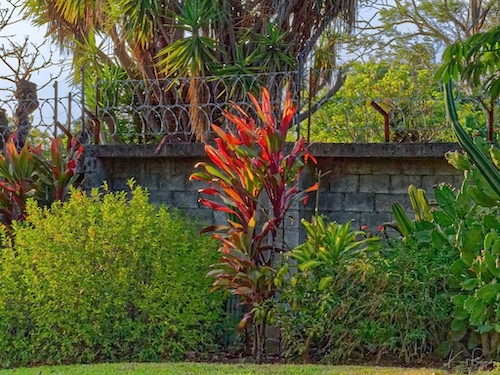
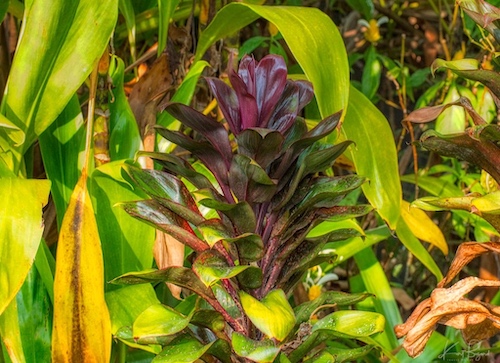
Cordyline fruticosa is an evergreen flowering plant in the family Asparagaceae. The plant is of great cultural importance to the traditional animistic religions of Austronesian and Papuan peoples of the Pacific Islands, New Zealand, Island Southeast Asia, and Papua New Guinea. It is also cultivated for food, traditional medicine, and as an ornamental for its variously colored leaves. It is identified by a wide variety of common names, including ti plant, palm lily, cabbage palm, and good luck plant. Its original native distribution is unknown, but it is believed to be native to the region from east Australasia. Ti is a palm-like plant growing up to 10–13 feet (3–4 m) tall with an attractive fan-like and spirally arranged cluster of broadly elongated leaves at the tip of the slender trunk. This is another of those quintessential tropical plants and there are many cultivars.
Bush Allamanda
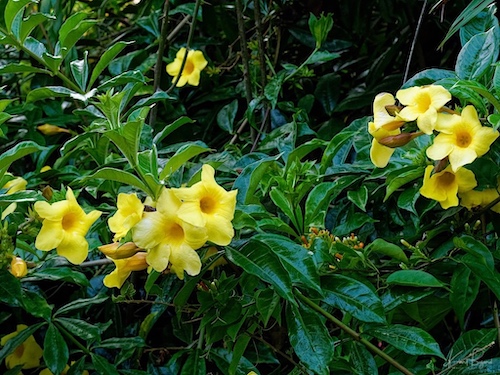
Allamanda schottii is found in the south and southeast of Brazil, in the states of Espírito Santo, Minas Gerais, Rio de Janeiro, São Paulo, Paraná and Santa Catarina. Previously considered endemic to that country, it was reported from northeastern Argentina in 2013. In Brazil, it grows near or alongside bodies of water, often in wet areas, in open or closed forests. Allamanda schottii has become naturalised in Puerto Rico, the Galapagos Islands and Costa Rica. It is reported to have escaped from cultivation in Australia.
Golden Trumpet Tree
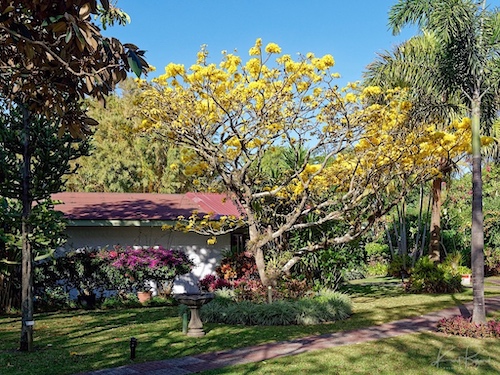
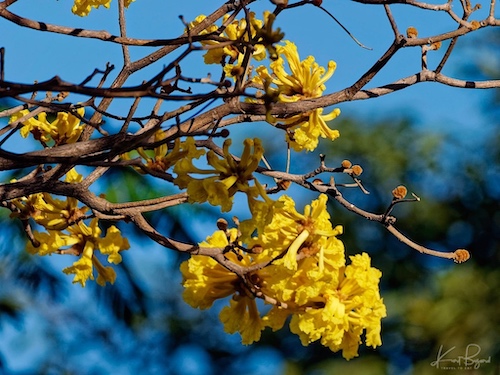
Tabebuia is a genus that comprises about seventy tree species native to the intertropical zone of America , extending from Mexico and the Caribbean, where most of the species are found. Some are found as far as central-northern Argentina and Paraguay. In 1970 a new genus (Handroanthus) was created to locate many of the Tabebuia species. It is the national tree of Paraguay , where it is called “tajy”. The species Handroanthus chrysanthus is the national tree of Venezuela since May 29, 1948 and is known as Araguaney.
Yellow Bells
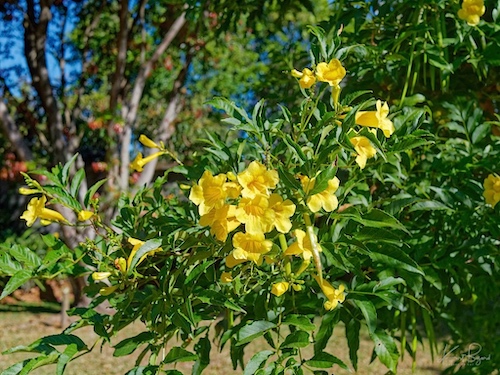
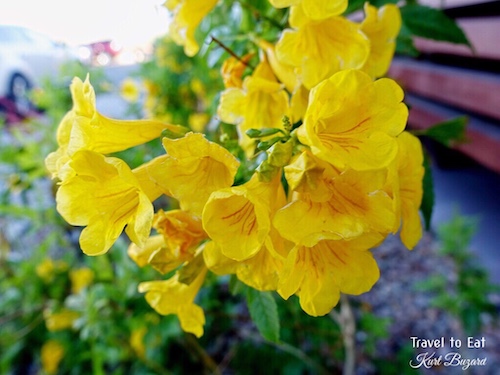
Tecoma stans is a species of flowering perennial shrub in the trumpet vine family, Bignoniaceae. it has an enormous natural range, extending from south Texas west to Arizona and south through Mexico and Central America to South America as far as northern Argentina, as well as in southern Florida south through much of the Caribbean. Plants native to the southwestern US and adjacent Mexico are Tecoma stans var. angustata, which is shorter, more drought-tolerant, and more cold-tolerant than some of the tropical varieties sold in nurseries. We have many of these in Las Vegas as they are good for low water landscapes. Common names include yellow trumpetbush, yellow bells, yellow elder, ginger-thomas. Tecoma stans is the official flower of the United States Virgin Islands and the floral emblem of The Bahamas.
Chipilín
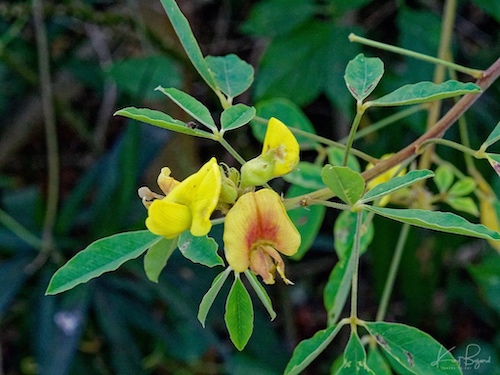
Crotalaria longirostrata, the chipilín, is a perennial legume that is native to Mexico and Central America. Other common names include chepil, chepilin, chipilin and longbeak rattlebox. Chipilín leaves are a common leafy vegetable in the local cuisines of southern Mexico, including Chiapas, Oaxaca, and Tabasco, and Central America, especially El Salvador and Guatemala. The leaves are high in iron, calcium, magnesium, and beta carotene. They can be boiled and served green, dried and used as an herb, or added to tamale doughs for color and flavor.
Golden Shrimp Plant
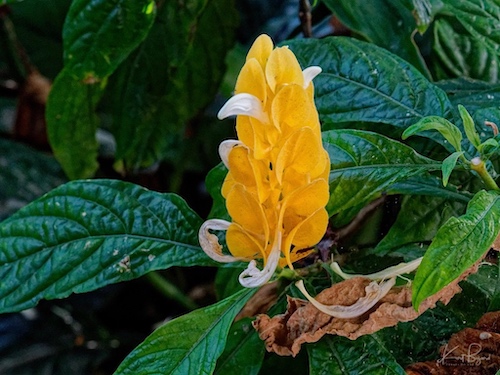
Pachystachys lutea, known by the common names lollipop plant and golden shrimp plant, is a subtropical, soft-stemmed evergreen shrub between 36 and 48 inches (90 and 120 cm) tall. The zygomorphic, long-throated, short-lived white flowers emerge sequentially from overlapping bright yellow bracts on racemes that are produced throughout the warm months. It is a popular landscape plant in tropical and subtropical areas of the world.
Giant Shrimp Plant
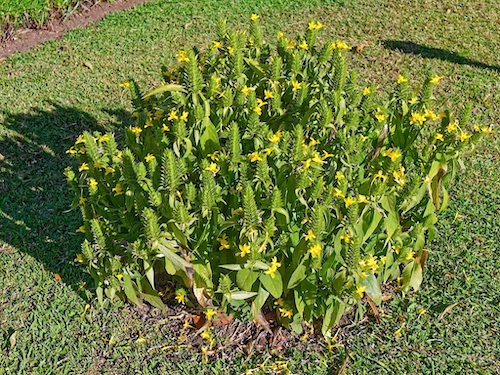
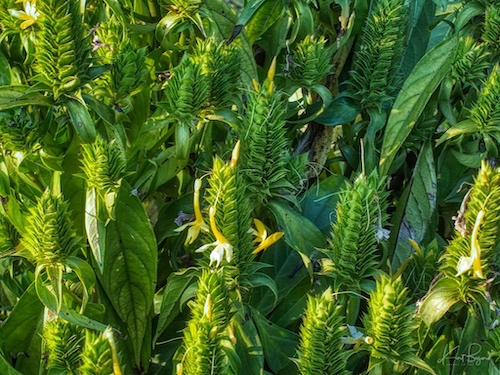

Barleria micans or the Giant Shrimp Plant is an interesting, tropical, woody subshrub in the family Acanthaceae that starts erect and then tends towards a more straggly form. It has simple lanceolate, veined, mid-green leaves. It produces attractive yellow trumpet-shaped flowers which emerge from a candle-like row of prickly green bracts, with protruding, contrasting darker yellow stamen. They are attractive to birds and butterflies. Barleria micans is originally from Mexico, Columbia and surrounding areas. A close relative to the Justicia, its flowers have a similar form, hence the common name of Shrimp Plant.
Balloon Plant
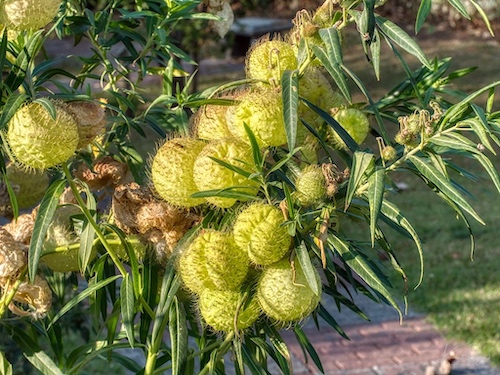
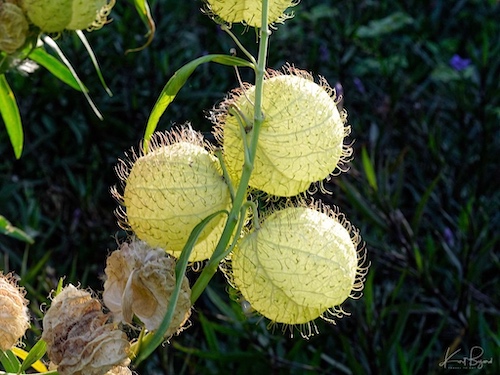
Gomphocarpus physocarpus, commonly known as hairy balls, balloonplant, balloon cotton-bush, bishop’s balls, nailhead, or swan plant, is a species of milkweed. The plant is native to southeast Africa, but it has been widely naturalized. It is often used as an ornamental plant. The name “hairy balls” is an allusion to the swelling testicle-like follicles which are full of seeds.
Stromanthe
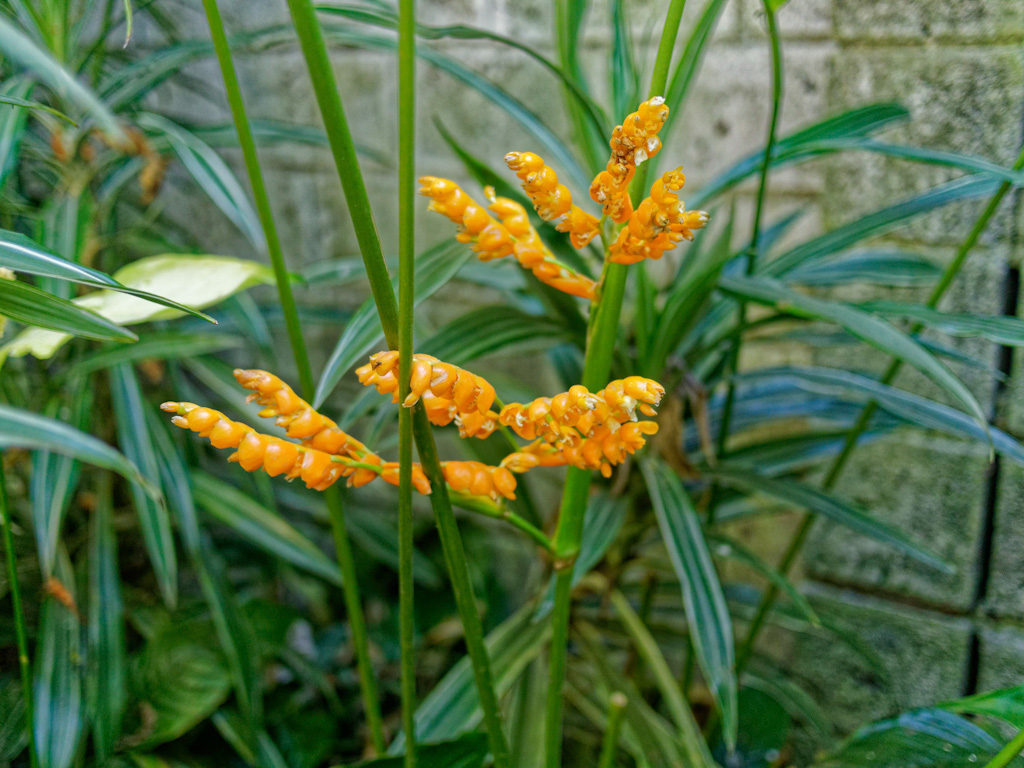
Stromanthe is a genus of plant in family Marantaceae, native to the tropical portions of the Americas from Mexico to Trinidadto northern Argentina. Rhizomatous and branched evergreen perennial with oval to elliptic leaves. Panicles of light orange/yellow flowers with bright orange/yellow bracts are borne in winter and spring. Sometimes referred to as Stromanthe jacquinii.
Star Jasmine
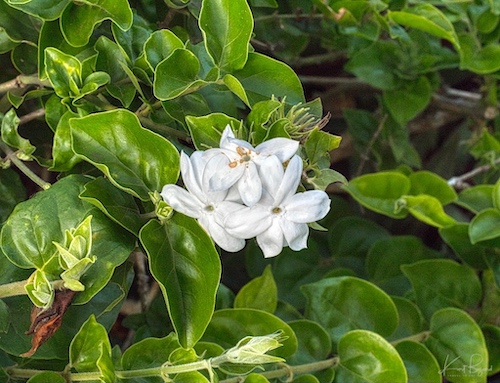
Jasminum multiflorum is native to India, Nepal, Bhutan, Laos, Burma, Thailand and Vietnam. It is widely cultivated in tropical and subtropical regions. While Jasmine flowers are known for its attractive and intensely fragrant flower, this species does not have any scent. The species is reportedly naturalised in Florida, Chiapas, Central America, Queensland and much of the West Indies. It is known as winter jasmine, Indian jasmine, downy jasmine, and star jasmine. It is called “Sanna jaaji malli” (సన్న జాజి మల్లి) in Telugu and “Kundo” (কুন্দ) in Bengali. In Indian mythology, Kund is known for its whiteness. So, instead of the common western phrase ‘white as snow’, what often appears in Hindu mythological stories is ‘white as kunda’. Also, beautiful white teeth are often compared to Kunda buds. It is held to be especially sacred to Vishnu. In Manipur, Kundo flowers are used in worship, and are an essential part of a marriage ceremony. The bride garlands the groom with two Kundo flower garlands. The groom then takes one of the two and garlands the bride.
White Sky Flower
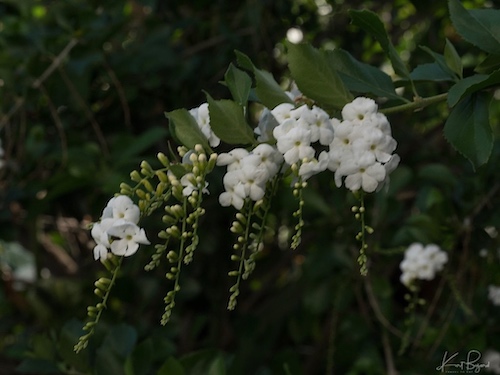
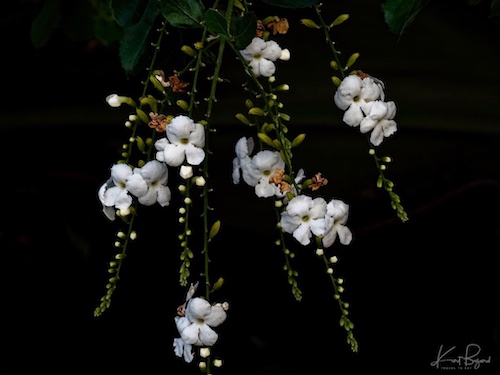
Duranta erecta is a species of flowering shrub in the verbena family Verbenaceae, native from Mexico to South America and the Caribbean. It is widely cultivated as an ornamental plant in tropical and subtropical gardens throughout the world, and has become naturalized in many places. It is considered an invasive species in Australia, China, South Africa and on several Pacific Islands. Common names include golden dewdrop, pigeon berry, and skyflower. In Mexico, the native Nahuatl name for the plant is xcambocoché. The native flower is purple. Interestingly this is another plant, along with Porterweed, that I consistently find when visiting butterfly conservatories and hummingbird feeding stations. Considered a native of southern Florida, the Skyflower can grow into a small tree or large shrub in freeze free areas but will often act like a die-back perennial in mild winter areas. Periodic removal of the spent flower clusters will promote more flowers instead of fruit.
Plumaria
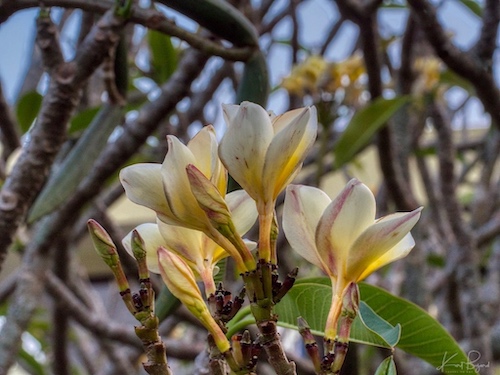
Plumeria alba is a species of the genus Plumeria (Apocynaceae). This 6 to 32 feet (2–8 m) deciduous shrub has narrow elongated leaves, large and strongly perfumed white flowers with a yellow center. Native to Central America and the Caribbean, it is now common and naturalized in southern and southeastern Asia. It is the national flower of Laos, known as Dok Champa and the symbol of luck.
Peruvian Lily
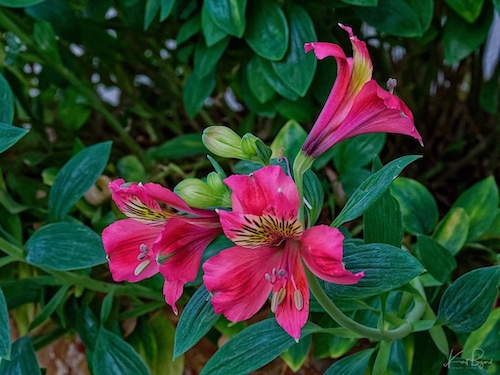
Alstroemeria psittacina, with the common names Peruvian lily, parrot flower, parrot lily, lily of the Incas, and princess lily. It is a native plant of the Cerrado and Pantanal vegetation in Brazil and Argentina. It is a popular ornamental plant in New Zealand and nurseries worldwide, where it usually blooms at Christmas because that it is also called New Zealand Christmas bell. In addition, this plant is cited as an invasive plant, and it is a natural host range of the Alstroemeria mosaic potyvirus.
Madagascar Periwinkle
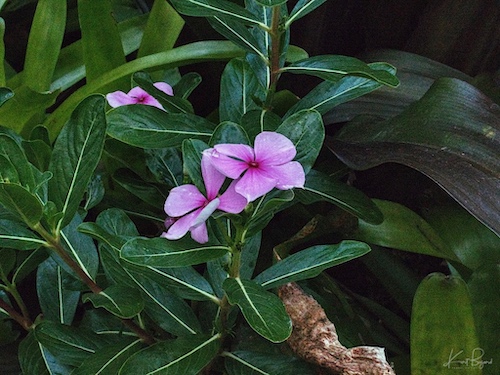
Catharanthus roseus, commonly known as bright eyes, Cape periwinkle, graveyard plant, Madagascar periwinkle, old maid, pink periwinkle, rose periwinkle, is a species of flowering plant in the dogbane family Apocynaceae. It is native and endemic to Madagascar, but grown elsewhere as an ornamental and medicinal plant. Periwinkles are of two types – Foliage periwinkle (which often grows wild on cliffs) and Annual periwinkle (Catharanthus roseus). In the wild, C. roseus is an endangered plant; the main cause of decline is habitat destruction by slash and burn agriculture. It is also, however, widely cultivated and is naturalised in subtropical and tropical areas of the world like Australia, Malaysia, India, Pakistan and Bangladesh.
Shining Mandevilla
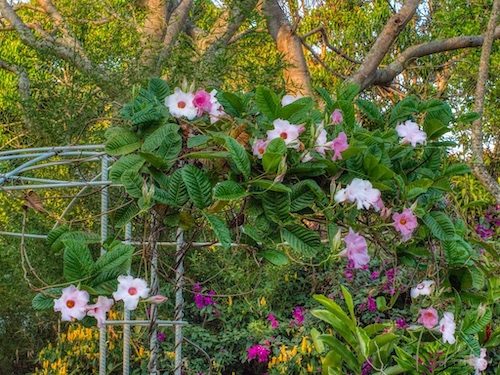
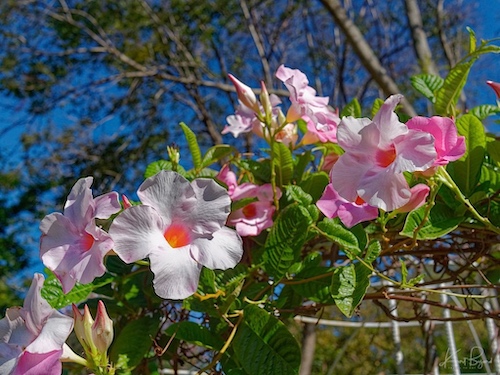
Mandevilla splendens (shining mandevilla) also called Dipladenia splendens, is a species of flowering plant in the dogbane family Apocynaceae. It is an evergreen vine, native to Brazil. It climbs by twining and can grow to 10 feet (3 m) high. It has wide green glossy leaves of elliptical or rectangular shape growing to 8 inches (20 cm) long. The flowers are rose-pink with yellow centers, appearing from late spring to early summer. They are up to 4 inches (10 cm) in length. The ‘Rosacea’ cultivars have deeply ribbed leaves.
Globe Amaranth
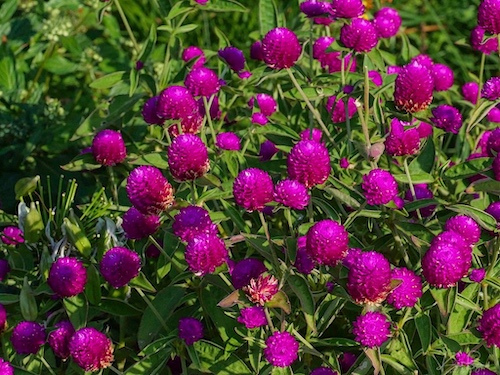
Gomphrena globosa, commonly known as globe amaranth, makhmali, and vadamalli, is an edible plant from the family Amaranthaceae. The round-shaped flower inflorescences are a visually dominant feature and cultivars have been propagated to exhibit shades of magenta, purple, red, orange, white, pink, and lilac. Within the flowerheads, the true flowers are small and inconspicuous. It is native to Central America including regions of Brazil, Panama, and Guatemala, but is now grown globally. As a tropical annual plant, Gomphrena globosa blooms continuously throughout summer and early fall.
Blue Butterfly Bush
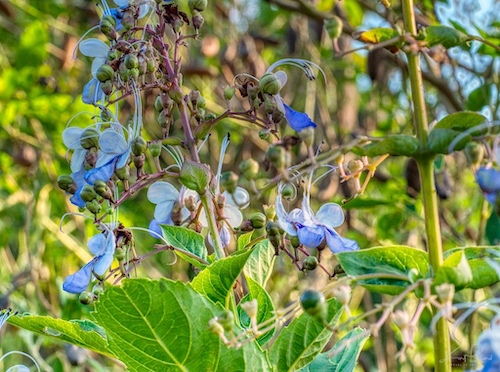
Rotheca myricoides is a species of flowering plant in the family Lamiaceae. It is native to Africa and widely cultivated elsewhere. In cultivation, it is frequently known by one of its synonyms, such as Clerodendrum myricoides or Clerodendrum myricoides ‘Ugandense’. This is a plant you really have to see in person to appreciate. Somewhat like the yellow Japanese Honeysuckle (Lonicera japonica), the delicate flowers are really beautiful to behold.
Orchids
Cattlianthe Hybrid Orchid
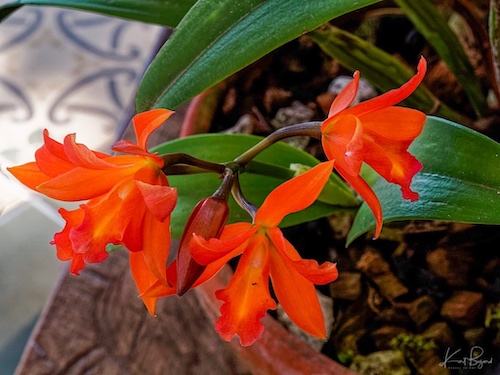
× Sophrolaeliocattleya (from Sophronitis, Laelia and Cattleya, its parent genera) is a nothogenus of artificial intergeneric orchid hybrids. It is abbreviated as Slc. in the horticultural trade. Hybrids can be specified either by a “hybrid formula” that specifies the parentage, or may be given a name. For hybrids receiving a hybrid name, the same ranks apply, prefixed with notho (Greek: ‘bastard’), with nothogenus as the highest permitted rank. As of 2008, × Sophrolaeliocattleya is defunct, with the genus Sophronitis having been merged into Cattleya. Thus X Sophrolaeliocattleya (Slc.) and Cattlianthe (Ctt.) are synonyms. “Cattlianthe” is now the recognized name. All of this naming nonsense aside, Sophronitis hybrids are commonly crossed to produce a desirable orange or red bloom not generally present in Cattleya hybrids not involving Sophronitis, and the compact shape is well suited for artificial light gardens.
Dancing Ladies Orchids
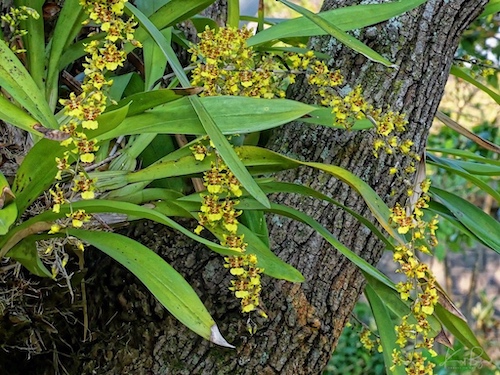
Oncidium is an extraordinarily large and diverse New World genus with an equally diverse number of habitats. Oncidiums may originate anywhere from sea level in the tropics to the high elevations of the Andes. Oncidium sphacelatum is a species of orchid ranging from Mexico to Central America, southeastern Venezuela. It is known as Kandyan dancer orchid in Sri Lanka due to its resemblance like Kandyan dancer.
Small-Funneled Lip Dendrobium Orchid
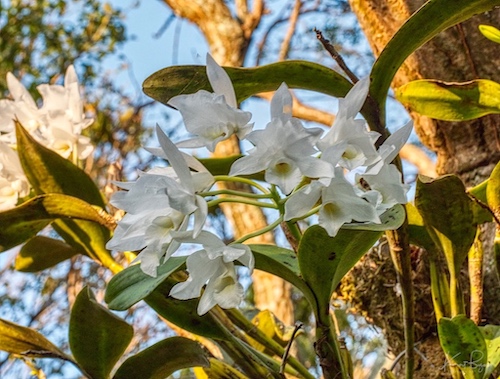
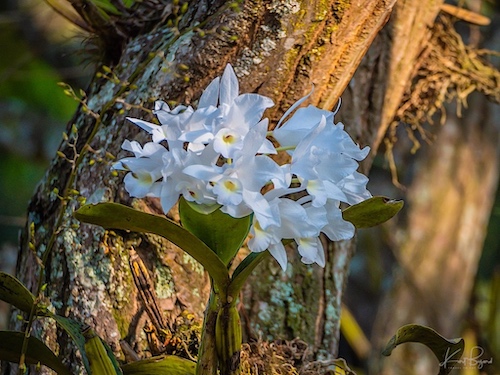
Dendrobium infundibulum, the small-funnel-lipped dendrobium, is a species of orchid. It is native to northern Indochina (Laos, Thailand, Vietnam, Myanmar) and to neighboring parts of China and India (Yunnan and Assam). They usually grow in deciduous or semi-deciduous forests, at heights of 3200–7500 feet (1000–2300 m) although they have been found at near sea level.
Guaria Morada
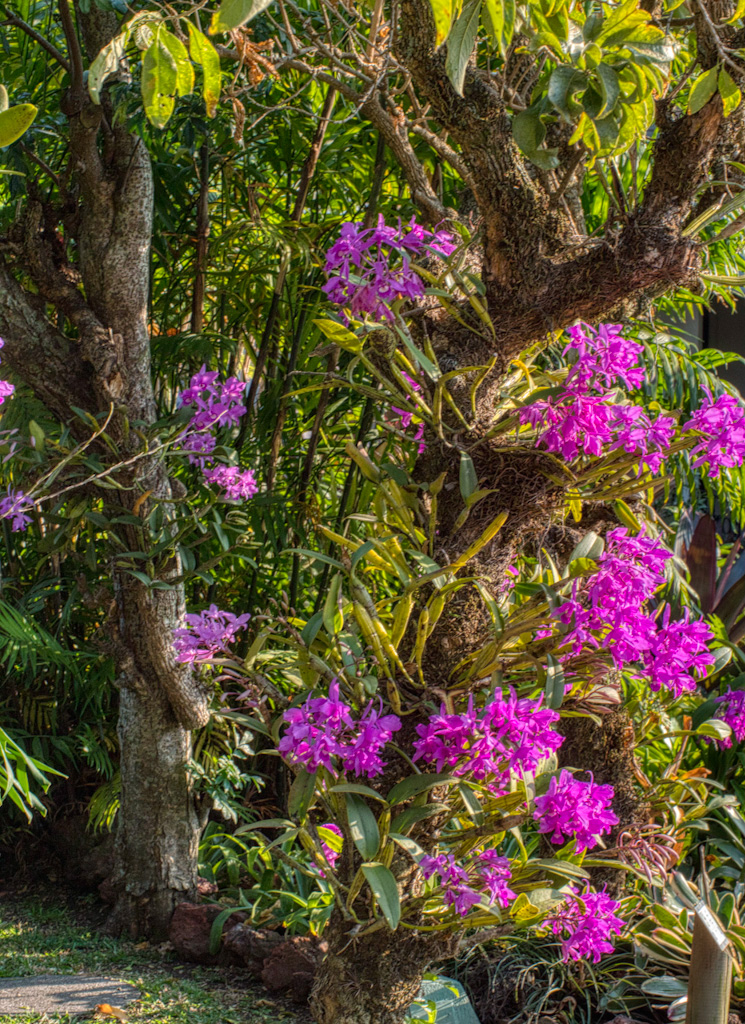
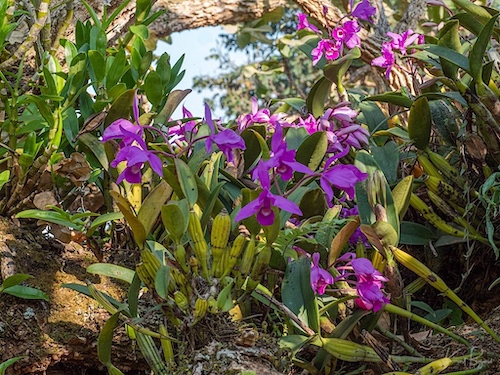
While still called Cattleya skinneri by many, Guarianthe skinneri was segregated out of Cattleya by Dressler and Higgins, along with other Central American cattleyas, in 2003. The range of Guarianthe skinneri extends from the southern Mexican border into Costa Rica where it is the national flower. There it is known as “Guaria Morada” and plays a role in local folk tradition. Plants are typically found in humid forests at moderate elevations growing on trees or rocks. Often, trees are deciduous in the habitat, providing a clue for this orchid’s culture.
Vanda luzonica Orchid
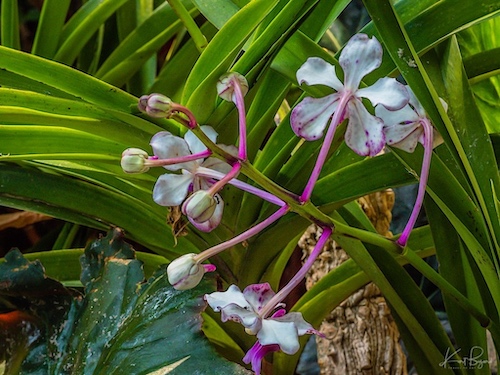
Vanda luzonica is a species of vanda, a flower of the orchid family. It is a rare type of orchid and is endangered. Vanda luzonica is named after the island of Luzon in the Philippines. Vanda luzonica is epiphytic and can grow quite large(growing up to 3 feet (1 m) long. It has leathery leaves growing from 8–20 in (20–50 cm) long. Its flowers look similar to those of Vanda tricolor. The flowers are spaced loosely and are a bit waxy. The sepals and petals of this orchid are white with purple streaks and pink spots near the tips.
Bromeliads
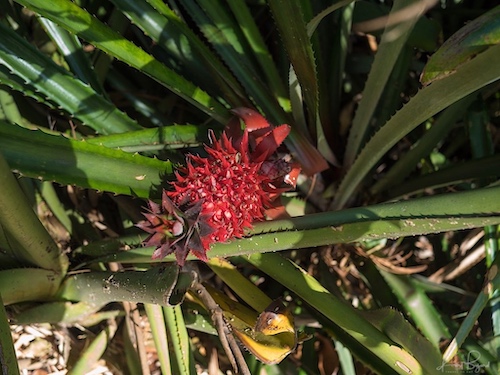
Ananas bracteatus is a large, short-lived, perennial, terrestrial species of bromeliad native to South America (Brazil, Bolivia, Argentina, Paraguay, Ecuador). This species is considered more of an ornamental plant with its decorative red fruit and pretty flower, the fruit is in fact deliciously edible once fully ripe.
Alcantarea imperialis/Vriesea imperilis
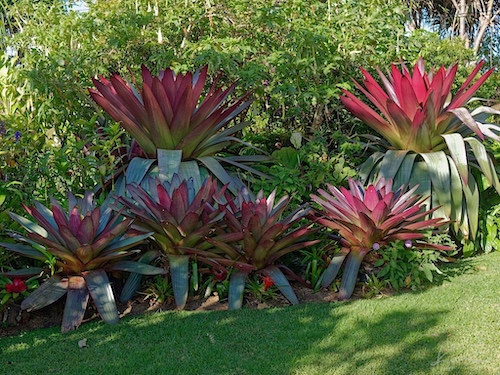
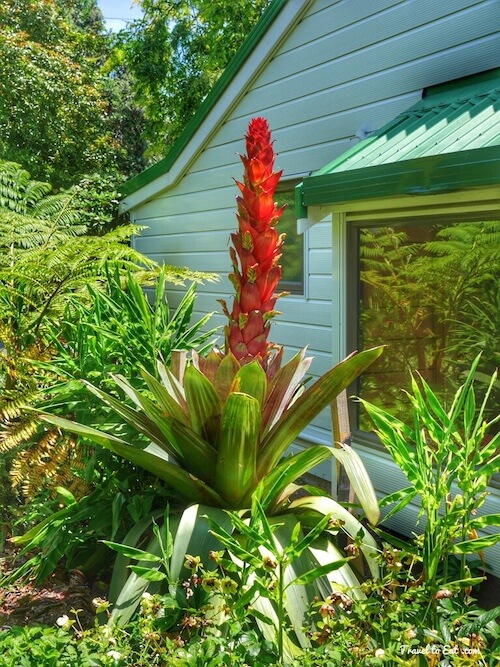
This large terrestrial bromeliad was once classified as Vriesea imperialis but is now recognized as part of the genus Alcantarea. It can be found growing on rocky slopes in the Serra dos Órgãos in Rio de Janeiro. It can tolerate dry conditions and full sunlight. Considered one of the giants of the genus, “its leathery leaves measuring 6 inches in width and 5 feet in length.” It will take years before producing an imposing red inflorescence that reaches 8 feet in height.
Guzmania lingulata
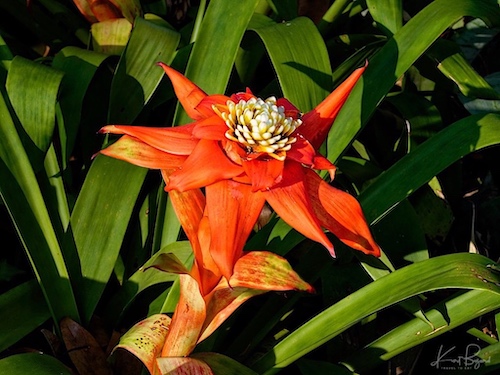
Guzmania lingulata, the droophead tufted airplant or scarlet star, is a species of flowering plant in the family Bromeliaceae, subfamily Tillandsioideae, native to rainforest habitats in Central America, northern and central South America, southern Mexico and the West Indies. It is an evergreen epiphytic perennial. The Latin word lingulata means “tongue-shaped”. Foliage grows in a star-shaped basal rosette which culminates in an orange and red bracted inflorescence. It is among the most commonly cultivated bromeliad types, with cultivars producing flowers in shades of maroon, red, orange, yellow or pink.
Guzmania wittmackii
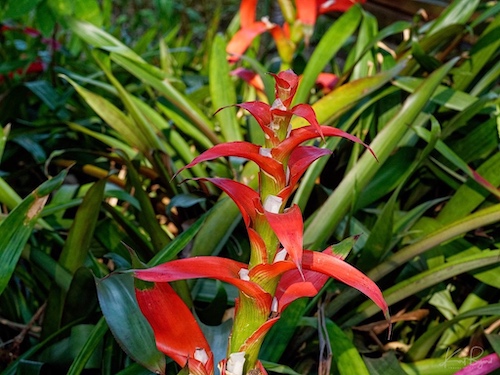
Guzmania wittmackii (André) André ex Mez (1896) is a bromeliad native to the humid forests of the coastline and of the Andes zones, up to 2000 m of altitude, of Colombia and Ecuador.
Tillandsia leiboldiana
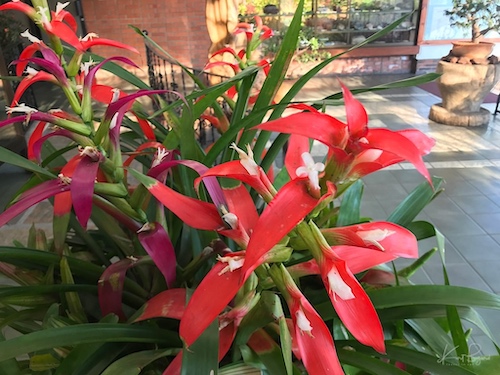
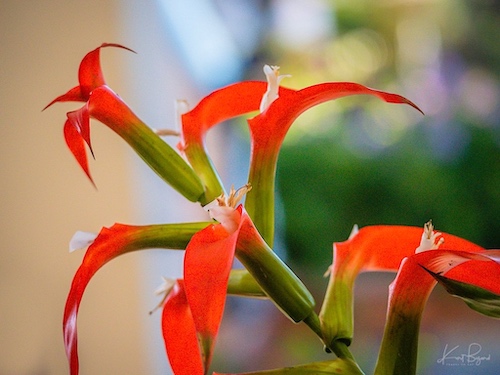
Tillandsia leiboldiana is a bromeliad in the genus Tillandsia. This species is native to Central America and Mexico, especially from southern Mexico to Costa Rica. It is an epiphytic plant that grows at altitudes between 0 and 1300 meters above sea level.
Wallisia anceps
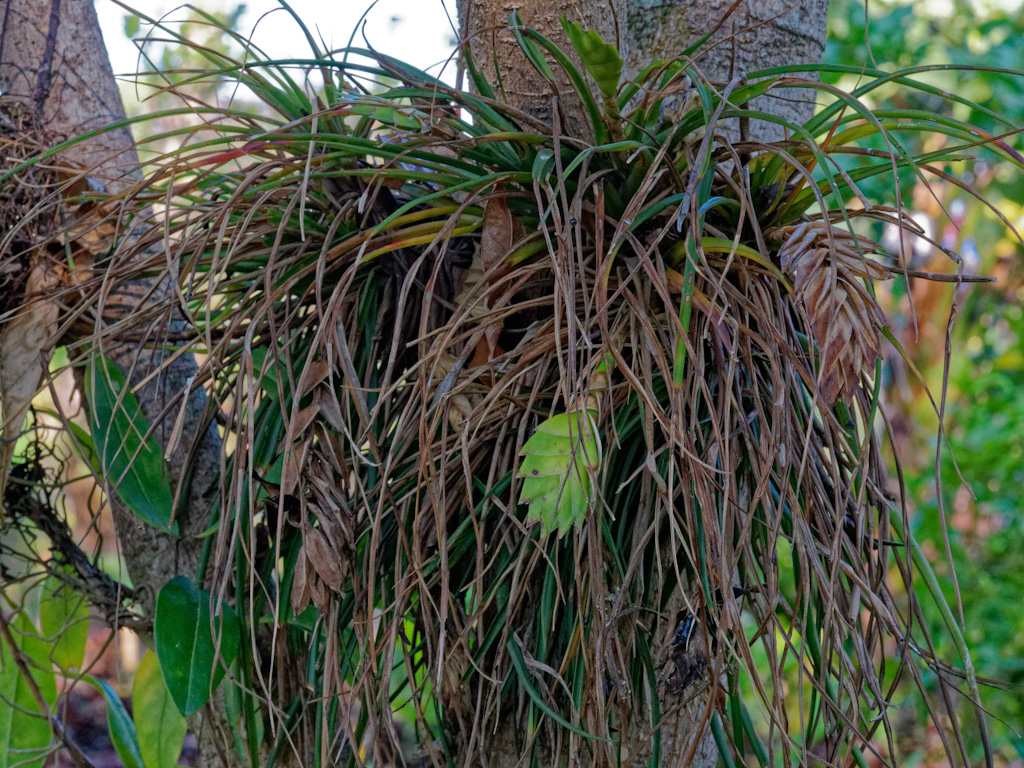
Tillandsia anceps is a species in the genus Tillandsia. This species is native to Central America, Colombia, Ecuador, Trinidad and Tobago, the Guianas, Venezuela and northern Brazil.
Neoregelia carolinae
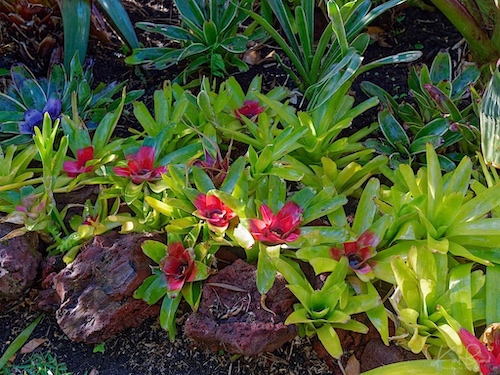
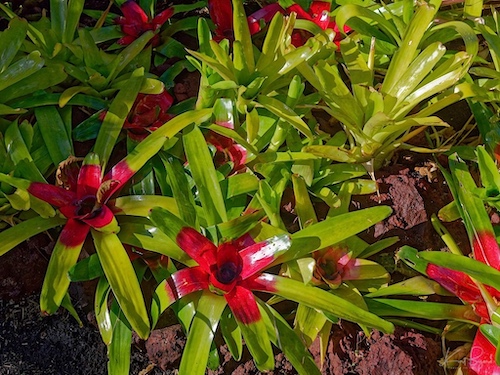
Neoregelia carolinae or Blushing Bromeliad is a species in the genus Neoregelia. It is noted for its center turning red when it’s about to flower, from where the common name (Blushing) is derived. Native to Brazil, it’s one of the most commonly grown bromeliads – typically grown as a houseplant. Despite being an epiphyte, a plant that grows on other plants and derives its nutrients from the air, it’s happy growing in a pot of compost. Forming a rosette of slim, strap-like leaves, it bears a cluster of small, inconspicuous flowers before developing off-shoots and dying.
Vriesea hieroglyphica
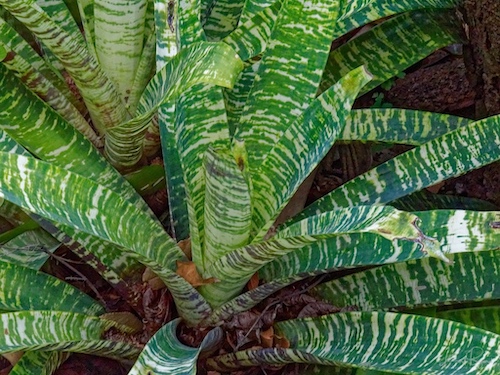
Vriesea hieroglyphica is a plant species in the genus Vriesea. The name refers to the linear horizontal patterns on the leaves that resemble hieroglyphs. It has been nicknamed “King of the Bromeliads.” It features striking, large, deep green leaves that have unusual, hieroglyph-like white banding and recurved tips. The leaves form a rosette of that can be as large as 5 feet (1.5m) in diameter.
Aechmea blanchetiana
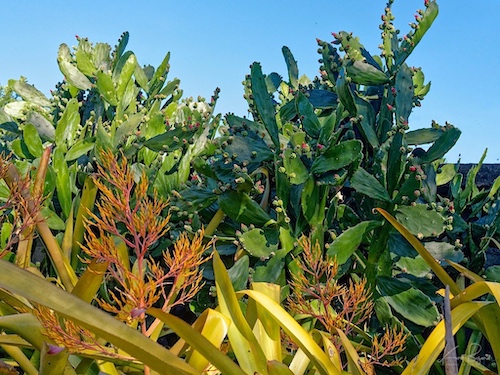
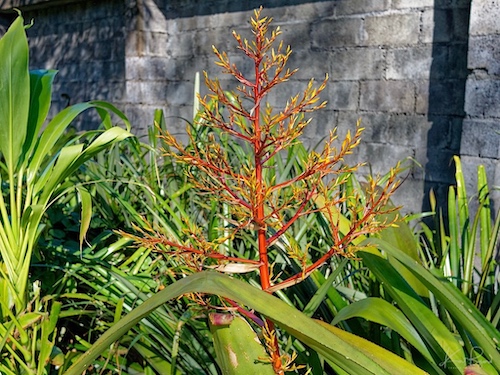
Aechmea blanchetiana is a bromeliad typical of Atlantic Coast restingas vegetation which is an ecosystem of Atlantic Forest biome of eastern Brazil. This plant grows from the State of Bahia south to Espírito Santo. It is often grown elsewhere (particularly in Florida and Southern California) as an ornamental plant. Aechmea blanchetiana is both a terrestrial or epiphytic bromeliad which attains a height of up to 4 feet (1.2 m) and a width of at least 3 feet. (1 m). The color of its leaves ranges from reddish gold, orangish gold, goldish yellow to green, depending upon the amount of sunlight it receives. The salmon pink flowers are tiny and ephemeral, but the red and yellow bracts that surround them remain ornamental for months. The inflorescence can reach 6’ tall.
Aechmea tillandisiodes
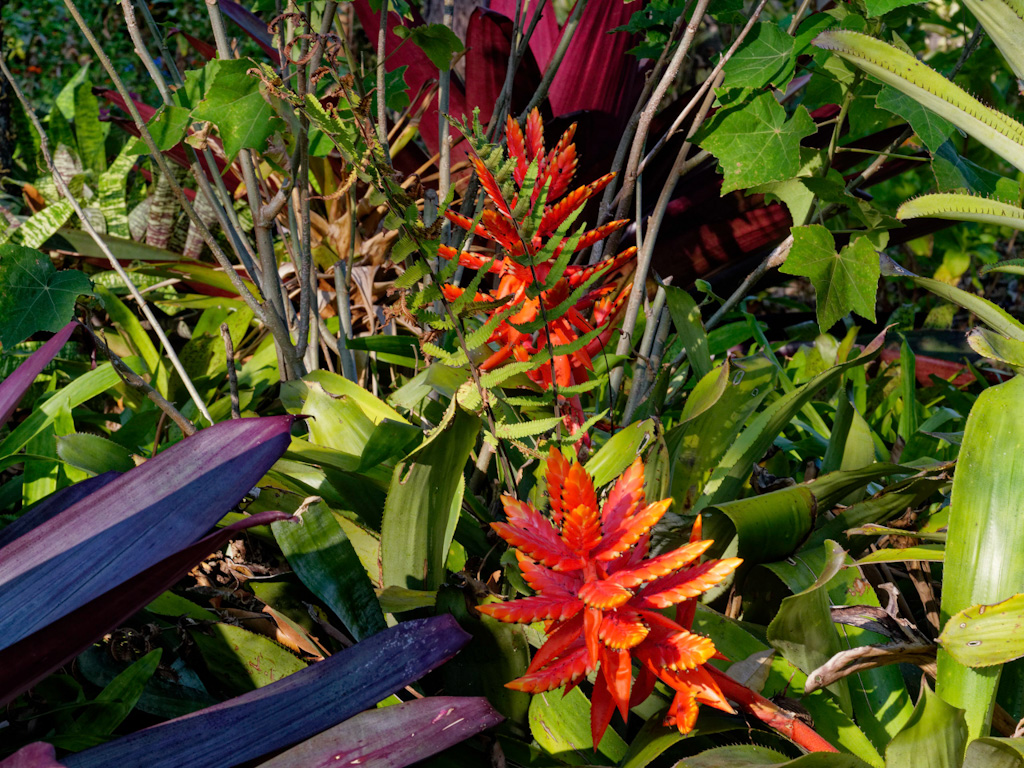
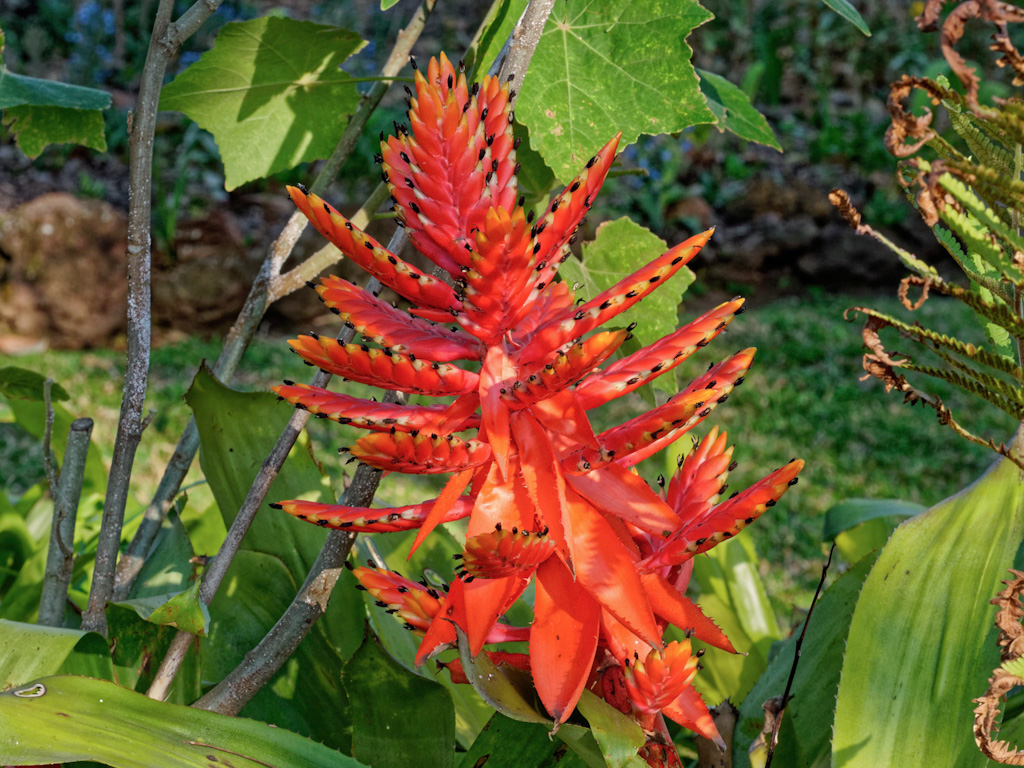
Aechmea tillandsioides is a showy exotic bromeliad native to southern Mexico, Central and northern South America. It is widely cultivated in other regions as a tropical ornamental. This plant is cited in Flora Brasiliensis by Carl Friedrich Philipp von Martius and is a real must for all plant enthusiasts.

As always, I hope you enjoyed the post, the gardens of the Hotel Bougainvillea are a lovely destination in Costa Rica.
References:
The 10 Most Beautiful Zinnia Flowers
Rotheca myricoides/Clerodendrum myricoides
Orchids at the Conservatory of Flowers
Oncidium: American Orchid Society
Dendrobium infundibulum Orchid
Alcantarea imperialis. Eden Garden, Auckland, New Zealand
http://www.bromeliad.org.au/pictures/Tillandsia/lindenii.htm
